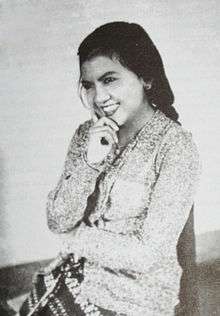Soerip
Soerip (Perfected Spelling: Surip; 22 October 1921 – 7 May 1992) was an Indonesian singer and film actress.
Anastasya Soerip | |
|---|---|
 Promotional image of Soerip for Panggilan Darah (1941) | |
| Born | 22 October 1921 |
| Died | 7 May 1992 (aged 70) |
| Occupation | Actress |
| Years active | 1940s–1990s |
Biography
Soerip was born in Banyuwangi, East Java, Dutch East Indies, on 22 October 1921. She only completed two years of elementary school before she dropped out.[1] She later became a kroncong singer, often billed as Miss Soerip. Owing to her habit of batting her eyelashes while singing, she was also nicknamed "Si Mata Roda".[2]
In 1940 Soerip made her feature film debut in Zoebaida, directed by Njoo Cheong Seng for Oriental Film.[2] This was followed in 1941 by Panggilan Darah, in which Soerip was cast with Dhalia as orphaned sisters who try to make a living in the colonial capital of Batavia (now Jakarta).[3] When the company folded, unable to recoup its expenses,[4] Soerip migrated to Majestic Film. She completed three productions for the company: Air Mata Iboe, Djantoeng Hati, and Pantjawarna.[5]
After the Japanese occupation of the Indies in March 1942, in which all but one domestic film studio was shut down, Soerip took a thirty-year hiatus from film, only returning to the industry in 1973 for Sopir Taxi. Owing to her age, she took the honorific Mbah (Grandmother), and was billed Mbah Soerip.[2] During the following two decades she completed a further 20 films, including productions by Slamet Rahardjo, Teguh Karya, and Wim Umboh.[5] A retrospective in Apa Siapa Film Indonesia particularly praises her performance in Rahardjo's Rembulan dan Matahari (1979).[6]
In 1990 Soerip made her last film, Cintaku di Way Kambas, and a soap opera, Bayang-Bayang. That year she was recognised by the National Film Council for her dedication to acting.[2] Soerip died on 7 May 1992 in Jakarta.[2]
Filmography
|
|
References
- Biran 1979, p. 480.
- JCG, Soerip, Miss.
- Filmindonesia.or.id, Panggilan Darah.
- Biran 2009, p. 229.
- Filmindonesia.or.id, Soerip.
- Apa Siapa 1999, p. 403.
Works cited
- Apa Siapa Orang Film Indonesia [What and Who: Film Figures in Indonesia] (in Indonesian). Jakarta: Indonesian Ministry of Information. 1999. OCLC 44427179.
- Biran, Misbach Yusa, ed. (1979). Apa Siapa Orang Film Indonesia 1926–1978 [What and Who: Film Figures in Indonesia, 1926–1978]. Sinematek Indonesia. OCLC 6655859.CS1 maint: ref=harv (link)
- Biran, Misbach Yusa (2009). Sejarah Film 1900–1950: Bikin Film di Jawa [History of Film 1900–1950: Making Films in Java] (in Indonesian). Jakarta: Komunitas Bamboo working with the Jakarta Art Council. ISBN 978-979-3731-58-2.CS1 maint: ref=harv (link)
- "Filmografi Soerip" [Filmography for Soerip]. filmindonesia.or.id (in Indonesian). Jakarta: Konfiden Foundation. Archived from the original on 30 March 2013. Retrieved 30 March 2013.
- "Panggilan Darah". filmindonesia.or.id (in Indonesian). Jakarta: Konfiden Foundation. Archived from the original on 26 July 2012. Retrieved 26 July 2012.
- "Soerip, Miss". Encyclopedia of Jakarta (in Indonesian). Jakarta City Government. Archived from the original on 30 March 2013. Retrieved 30 March 2013.